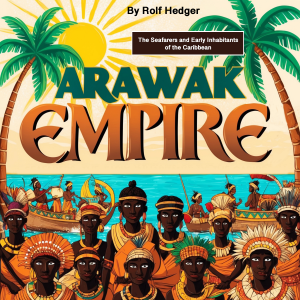

Arawak Empire
Rolf Hedger
The Arawak people trace their origins to the vast and resource-rich region of the Orinoco River basin in present-day Venezuela. As part of the larger Arawakan language family, they were one of the many groups that gradually expanded across South America and into the Caribbean. Their migration was driven by a combination of environmental factors, population growth, and the search for fertile land and abundant resources. Over generations, they navigated rivers, coastlines, and open waters, eventually settling in the islands of the Greater and Lesser Antilles, where they established thriving communities.
Archaeological evidence suggests that the Arawak migration into the Caribbean began around 2000 BCE, with the earliest settlements appearing in the Guianas and Trinidad before spreading to islands such as Hispaniola, Cuba, and Puerto Rico. The seafaring skills of the Arawak were instrumental in their expansion, allowing them to cross large distances using well-crafted dugout canoes. These vessels, some of which could carry dozens of people, enabled them to transport goods, establish trade networks, and maintain cultural connections between islands.
The Arawak developed a rich cultural identity deeply connected to their environment. They were skilled agriculturalists, cultivating staple crops such as cassava, maize, sweet potatoes, and fruits like guava and pineapple. Their farming methods, including slash-and-burn techniques and mound cultivation, allowed them to sustain large populations and support the growth of permanent villages. In addition to agriculture, they engaged in fishing and hunting, making use of the diverse ecosystems found throughout the Caribbean.
Duration - 2h 42m.
Author - Rolf Hedger.
Narrator - Susan Heith.
Published Date - Monday, 27 January 2025.
Copyright - © 2025 Rolf Hedger ©.
Location:
United States
Description:
The Arawak people trace their origins to the vast and resource-rich region of the Orinoco River basin in present-day Venezuela. As part of the larger Arawakan language family, they were one of the many groups that gradually expanded across South America and into the Caribbean. Their migration was driven by a combination of environmental factors, population growth, and the search for fertile land and abundant resources. Over generations, they navigated rivers, coastlines, and open waters, eventually settling in the islands of the Greater and Lesser Antilles, where they established thriving communities. Archaeological evidence suggests that the Arawak migration into the Caribbean began around 2000 BCE, with the earliest settlements appearing in the Guianas and Trinidad before spreading to islands such as Hispaniola, Cuba, and Puerto Rico. The seafaring skills of the Arawak were instrumental in their expansion, allowing them to cross large distances using well-crafted dugout canoes. These vessels, some of which could carry dozens of people, enabled them to transport goods, establish trade networks, and maintain cultural connections between islands. The Arawak developed a rich cultural identity deeply connected to their environment. They were skilled agriculturalists, cultivating staple crops such as cassava, maize, sweet potatoes, and fruits like guava and pineapple. Their farming methods, including slash-and-burn techniques and mound cultivation, allowed them to sustain large populations and support the growth of permanent villages. In addition to agriculture, they engaged in fishing and hunting, making use of the diverse ecosystems found throughout the Caribbean. Duration - 2h 42m. Author - Rolf Hedger. Narrator - Susan Heith. Published Date - Monday, 27 January 2025. Copyright - © 2025 Rolf Hedger ©.
Language:
English
Opening Credits
Duration:00:00:07
1 arawak empire
Duration:00:13:10
2 arawak empire
Duration:00:13:38
3 arawak empire
Duration:00:13:21
4 arawak empire
Duration:00:12:54
5 arawak empire
Duration:00:13:20
6 arawak empire
Duration:00:13:16
7 arawak empire
Duration:00:13:37
8 arawak empire
Duration:00:13:20
9 arawak empire
Duration:00:13:00
10 arawak empire
Duration:00:12:54
11 arawak empire
Duration:00:13:00
12 arawak empire
Duration:00:13:51
Conclusionm arawak empire
Duration:00:03:17
Ending Credits
Duration:00:00:09